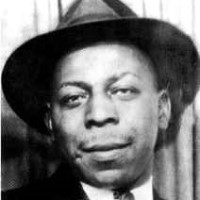Home » Jazz Musicians » Big Maceo
Big Maceo
By the mid 1930’s, there had been a significant change in the nature of blues piano. The piano blues and boogie-woogie of the “first generation” pianists had for the most part been a series of solo performances, augmented occasionally by perhaps a guitar. Boogie was a folk music; centered in a Northern city and always closely related to urban surroundings, but it still retained a certain flavor of its Southern and Mid-Western origins. The boogie-woogie and slow piano styles, deeply rooted in the tradition of the twelve-bar blues, laid the firm foundations on which the new form of an old music was based. And of these pianists none was the peer of Major “Big Maceo” Merriweather. Major Merriweather was born on the outskirts of Atlanta on March 31, 1905 on his family's farm, one of 11 children. As he grew older he would eventually stand well over six-feet and weigh more than 250 pounds, which garnered his nickname "Big." In 1920, the family moved to the College Park section of town and the young Major developed an affinity for the piano. He began working the cafes and honky tonks located on Harvard Street, as well as playing at house rent parties and fish fries throughout the city. In 1924, at the age of 19, his family relocated to Detroit. Hattie Spruel first met Maceo when she hired him to play for parties in her home. They were soon married and Hattie went to work to make a name for her new husband. The couple moved to Chicago in 1941, where she made the acquaintance of prominent guitarists Big Bill Broonzy and Tampa Red. She introduced them to Maceo and the two were impressed with his skills. They brought him to the attention of RCA's master producer, Lester Melrose, and within just a few weeks Maceo was recording for the famed Bluebird label. The first session would prove to be extremely fruitful for Big Maceo, as his friends called him. He recorded a total of 14 sides, with the first single becoming the most important of his career: "Worried Life Blues". Major Merriweather played a powerful piano in and had no need for instrumental support, but in fact he seldom played without at least a guitar for accompaniment. In Tampa Red he found a guitarist whose style was sympathetic to his own work, and a close friend in the man himself.
Read moreTags
Photos
Music
Recordings: As Leader | As Sideperson
























